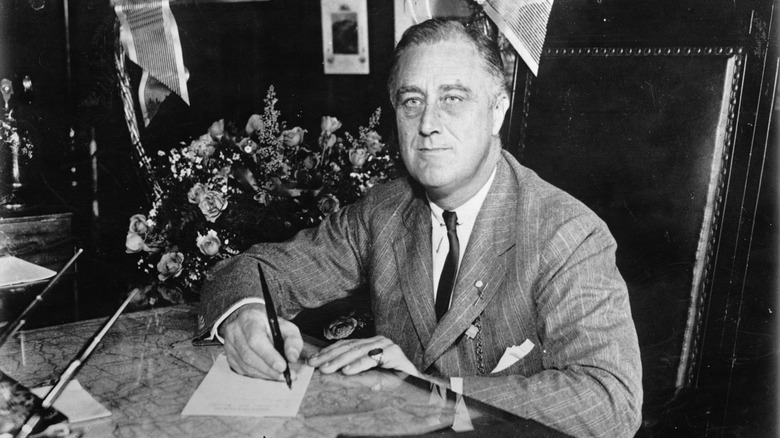Thanksgiving Was Celebrated Twice In 1939 Due To A Confusing Change By Franklin Roosevelt
What's not to love about Thanksgiving? The festive get-together with family and friends unofficially kicks off the holiday season, plus it's packed with good feels, from the pumpkin pie to the fall chill in the air, the turkey, stuffing, cranberries, and family traditions. Perhaps it's such a wonderful holiday that it should be celebrated twice a year? That actually happened in 1939, according to the San Diego Union-Tribune, but it wasn't due to popular demand.
Back in 1863, President Lincoln proclaimed Thanksgiving should occur on the last Thursday in November, according to the Saturday Evening Post. And that's the way it was until 1939, when President Franklin D. Roosevelt made the momentous and controversial decision to move it. Roosevelt's motivation was rooted in helping the nation's struggling economy, according to Forbes. That year, the last Thursday of November was also the last day of the month, November 30, meaning the holiday shopping season would be a short one — just 24 days, since it usually kicks into full swing the day after Thanksgiving. Roosevelt wanted to give shoppers more days to shop in order to stimulate the economy.
A 'perfectly movable feast'?
In announcing his plan to move Thanksgiving, Roosevelt called the holiday a "perfectly movable feast," saying, "There is nothing sacred about it," according to Forbes. A large number of Americans thought otherwise. Turkey farmers worried moving Thanksgiving up a week would cost them a lot of money, because their birds wouldn't be ready in time. Football teams also opposed the idea; they'd already set their schedules for the year, with their last games on Thanksgiving Day, according to The Saturday Evening Post.
Many governors also disagreed with the plan, which would come to be known as "Franksgiving." The former governor of Kansas, who ran against FDR in 1936, was among the dissenters. Alf M. Landon likened the way Roosevelt brought on the change to acting "with the omnipotence of Hitler," according to Forbes. Yet the idea delighted many in the business community, especially those who owned department stores. One said he thought the move could pour $1 billion into the economy — about $18.7 billion in today's money, according to Forbes.
From two Thanksgivings back to one
Of the 48 states then part of the nation, more than 22 decided to go along with early Thanksgiving, while 23 others refused. Mississippi remained undecided, while Texas and Colorado decided to celebrate both, according to Time. So in 1939, Thanksgiving was a patchwork affair in the country. Some Americans sat down for the feast a week earlier than usual, while others marked the holiday on the same date they always had.
After it was over and the economic numbers were in, the results were mixed as to whether moving Thanksgiving actually gave the economy a boost. The U.S. retail sales numbers for November and December showed a 10% increase from the year before, according to Forbes. But there was disagreement as to whether moving the holiday was the cause.
Two more years of dueling Thanksgivings were held in 1940 and 1941 before Roosevelt backed off the idea and declared that starting in 1942 Thanksgiving would be celebrated on its original date. A few months later, Congress set about giving the holiday one official date: the fourth Thursday of November. President Roosevelt signed the resolution on December 26, 1941, according to the Center for Legislative Archives.


